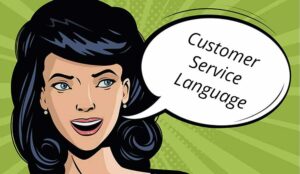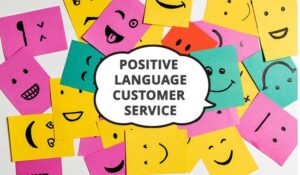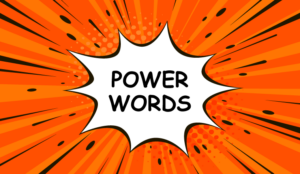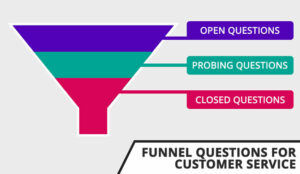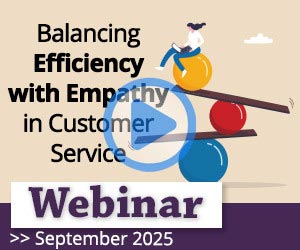Great customer service starts with the right words, and the language used in contact centres can make or break a conversation.
From greetings and positive phrasing to managing difficult calls, the tone and style of communication play a crucial role in shaping the customer experience.
In this article, we share examples of professional language for customer service, which can be used in different scenarios.
11 Practical Examples of Customer Service Language
1. Greeting Customers
A positive, energetic opening can help set the tone for the rest of the conversation.
Examples of call greeting statements:
- “Welcome to X Company’s customer service. My name is John. How can I help you?”
- “Good afternoon! You’re through to X Company. My name is John. How may I help you?”
- “Hi, my name is John. I’m a Customer Service Advisor here at X Company. How can I help?”
In each of these examples, the advisor gives the name of the company to reassure the customer that they are talking to the right person.
Also, the advisor uses their name and personal pronouns from the get-go, in the hope of sparking a positive conversation.
In the last statement, the advisor also presents their job title, which can prove helpful when looking to establish expertise, giving customers the indication that they’ve reached someone who can help them.
Sure, these little things may seem small, but they can definitely make a difference!
For more examples of call greeting statements, read our article: 10 Catchy Greeting Examples for Customer Service
2. Positive Words and Phrases
Sometimes an advisor can be tentative about showing enthusiasm and using positive words in conversations, even though they are built into a script.
Why? Because they are too shy to be upbeat.
Advisors may be uncomfortable using words such as “fantastic”, “wonderful” and “delightful”. This leads to phony positivity, which may be interpreted as inauthentic, damaging customer rapport.
So, leaders need to coach the use of the script carefully, especially with introverted advisors, and cultivate a positive culture.
This will help advisors to feel more confident in using positive words, including each of the following examples, to generate natural, engaging conversation.
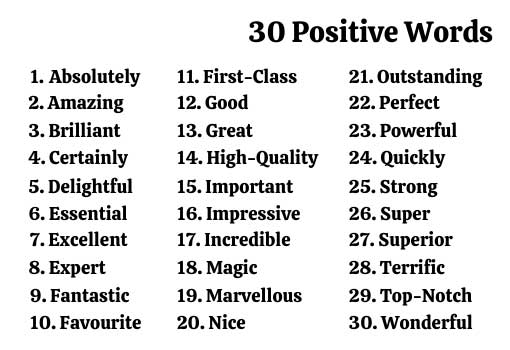
Paired with a positive attitude, these words can be powerful in creating great customer conversations – particularly when used as part of a compliment.
For example, any of the following compliments, which use some of the positive words highlighted above, can spark a positive connection with the customer:
- “It’s good that you’ve shared that with me because…”
- “It’s great that you live there, it’s such a nice place.”
- “I can see you’ve been a loyal customer, which is wonderful.”
Just remember, as the saying goes: “A compliment is the easiest thing to give and the nicest thing to receive.”
Find lots more examples of positive words and phrases for the contact centre in our article: Top 25 Positive Words, Phrases and Empathy Statements
3. Setting Expectations
“When a conversation doesn’t go the way that you want it to, it’s often because expectations haven’t been established at the start of the conversation. That or the call structure that a contact centre has coached fails to allow for good questioning,” says Martin Teasdale, host of the Get Out of Wrap podcast.
Martin’s quote here indicates that simple transactional contact types can be structured and coached upon for speedy resolutions and limited customer effort.
When contact centres do so, they can properly set customer expectations through signposting. Signposting involves the advisor telling the customer at the start of the conversation what will happen during the call and what information they will need.
For example, to signpost, an advisor may use professional language such as:
- “In a moment, I’ll need to take a few bits of information, including a debit card number to make the booking…”
- “I will be giving you a reference number, so you might want to quickly grab a pen to write it down, while I…”
- “Can you see a reference number in the top right-hand corner of the bill? If not, I can find out by taking your postcode.”
When the call type is simple and easy to structure, this method is customer-friendly, while it’s also a key hack to reduce average handling time.
For the more complex, emotional contact reasons, however, this is where questioning techniques enter the fray. These will enable superior problem-solving.
Want to learn more about how advisors can help to establish customer expectations? Well then, check out our article: How to Set the Right Expectations on a Call
4. Positive Scripting
Scripts are still frequently used in contact centres and positive scripting refers to the art of designing such a script to develop good, friendly customer conversations.
While many have negative opinions of scripts, they still do have a place in helping advisors reach a certain level of competence.
Filled with professional language for the contact centre, the script is best coached upon to allow advisors to improve.
Getting the language of the script right is, therefore, crucial. It sets a tone that advisors can build upon as they become more confident.
But what does the professional language within the script look like? Generally, it’s simple, personable and understandable.
For example, it will generally include language such as that included in the ‘green ‘positive scripting’ column of the table, rather than that shown in the ‘poor scripting’ column.
| Poor Scripting Examples | Positive Scripting Examples |
|---|---|
| “No problem…” | “Of course I can do that for you…” |
| “It’s company policy.” | “I can’t do that for you because… but what I can do for you is…” |
| “I’m sorry that your package hasn’t been delivered yet. You can track it online instead.” | “I’m sorry that your package hasn’t arrived yet. Let me check with the courier quickly and find out what is happening for you.” |
| “Please do not hesitate to contact us.” | “Please contact us if you have any questions about your… We’re happy to help.” |
The statements included in the “positive scripting” column are great because:
- They use personal pronouns – such as “I” and “you” to develop a more personable conversation.
- They refocus the conversation on the solution and what the contact centre can do.
- They use positive words – including “of course”, “quickly” and “happy” – to positively influence the conversation. (more on this later”)
Martin Teasdale highlights that: “There has been a definite shift to plain talk. It’s not dumbing down, it’s not simplifying, but it’s more natural and more customer-centric.
We’ve got to get away from just thinking of our customers as customers. We forget that customers are exactly the same as you and I.”
Scripts Are Just for Guidance
This is an important consideration for contact centre scripts. Advisors shouldn’t be commanded to stick to their scripts. They are there for guidance, just like all of the statements presented below.
Yet, whatever the stance on scripts, role-playing it through and discussing it with a customer panel are great exercises in understanding its effectiveness.
If you want more positive scripting examples, read our article: Positive Scripting For Customer Service – With Examples
5. Customer Service Questions
Open and Closed Questions
Let’s start with the basics. Open and closed questions. Advisors use open questions when gathering information and closed questions when looking for confirmation.
Open questions include those that begin with “how”, “what”, “when”, “where” and “who”. Closed questions start with “can”, “is”, “do” and “don’t”.
Just think “w” to open up the conversation and “d” to close it down. Here are a few examples.
| Open Questions | Closed Questions |
|---|---|
| How can I help you? | Can I help you? |
| What kind of noise is it making? | Can you hear a noise? |
| What are you looking to buy today? | Are you looking to buy something? |
| What features of our service do you like most? | Was our service satisfactory |
Probing Questions
Another great type of question is a probing question. This helps an advisor to delve into some specifics and, typically, comes after an open question to focus in on a particular area of interest.
A super secret to asking good probing questions is to use TED questions. These begin with “tell me”, “explain to me” and “describe to me”. For example:
When a customer is struggling to explain something, probing questions can help them out, while also uncovering grey areas in their response to the initial opening question.
After asking open questions and probing questions, advisors are often encouraged to use a closing question to confirm mutual understanding. This is known as the “funnel technique”, which is frequently used within customer service environments.
Learn about the funnel technique and how it can improve contact centre conversations: 10 Effective Questioning and Probing Techniques for Customer Service
6. Acknowledge, Empathize and Reassure
When a customer is clearly irritated by a problem, remember: feelings before facts. Acknowledge the customer’s problem, show empathy and reassure them that they have reached the right person to help them get to the bottom of their issue.
To do this, bring together your acknowledgement statements, empathy statements and reassurance statements to form super-statements that have the power to enhance the customer conversation.
Take a look at the powerful phrase below as an example:
“Thanks for alerting us to this problem. It seems to be a very frustrating issue. However, you’ve come to the right place. Let’s see how I can help.”
By tying together the three elements above, this statement shows support for the customer, before turning the conversation around to focus on finding the solution.
Of course, there are different horses for courses, and if the customer is really upset, sometimes more empathy is required. Emotionally intelligent advisors will realize this and react accordingly.
Emotional intelligence is a big topic and one with great value to the contact centre, as Sandra Thompson explores in our article: Emotional Intelligence FAQs Answered by an Expert
7. Customer Apologies
Yes, acknowledgement, empathy and reassurance are all great, but sometimes all a customer wants to hear are the words: “I’m sorry.”
But don’t make this a throwaway apology such as “I’m sorry for the inconvenience” just because “the customer is always right”. That’s only going to make things worse.
Make it authentic. It shouldn’t be made through gritted teeth. The advisor needs to make the effort to understand what they are really apologizing for.
After doing so, the advisor can say sorry sincerely by using a good apology statement that reflects back on the customer’s issue, demonstrating a clear understanding of the problem.
Matched with an empathetic tone, statements like the following can work wonders:
- “I’m so sorry about this. I can see how [INSERT PROBLEM] must have been really frustrating for you.”
- “I’m very sorry. I recognize that it can be difficult to deal with [INSERT PROBLEM].”
- “Thanks for making us aware of {INSERT PROBLEM]. I appreciate that it can’t have been easy for you and I’m sorry that we’ve made you feel {INSERT EXPRESSED EMOTION]”
With a sincere apology, the advisor can then revert to showing empathy, before taking responsibility and ownership of the customer’s issue.
Discover more about how to offer an authentic apology to customers by reading our article: Customer Service Apologies – Keeping Sorry Fresh and Sincere
8. Building Customer Rapport
The language of contact centres is becoming less formal, in the hope of forming more personal customer conversations and building better rapport. This, in theory, should bolster customer satisfaction.
One clear change that many contact centres are making in terms of language selection is removing those acronyms and expressions that may not make perfect sense to the customer.
“Break the barrier of internal language and company jargon that confuses customers and follow a path for more natural, positive and polite conversations,” says Roy Atkinson, Principal Advisor at Clifton Butterfield.
Yet there are many more changes that contact centres can make in terms of language to build better customer relationships. For example:
- Using language to create a sense of immediacy.
- Repeating back the customer’s problem so the customer knows that the advisor fully understands their issue.
- Recapping the call and making the customer feel part of the solution.
The first point is very important. While it’s a cliché to say “You’re our number one priority”, you can make the customer feel that way by using statements such as:
- I’m going to look into this right away…
- What I’m currently doing for you now is…
- That’s now been done for you, John.
By generating such a sense of immediacy you can ensure that the customer feels as though they are the priority and that their issue is of great importance.
Creating a sense of immediacy is just one way to use language to boost contact centre rapport. Find out more by reading our article: Best Tips, Phrases and Words to Use for Building Rapport
9. The Language of Sales
Not all contact centres are focused entirely on customer service. Sales is at the centre of many operations, and the language sales advisors use plays a big part in their success.
Traditional professional language for sales contact centres has included statements such as the following. But they all can negatively influence the outcome.
- “How are you today?” – Salespeople don’t have much time to capture the potential customer’s attention. It’s better to give a quick introduction and dive into the reason for calling.
- “You need to” – Make suggestions, not instructions. The customer doesn’t “need” to do anything, but the sales advisor can “suggest” ways to make things easier for the prospect.
- “Guarantee” – Sounds like a nice, positive buzzword, right? Well, not really. It’s classic, outdates sales language that alerts the customer to the fact that this is just a generic sales call.
Instead analyse successful sales calls and create cheat sheets filled with great language, which can – like with scripts – be role-played. This will enable advisors to feel comfortable in using the new language, so it begins to feel natural.
As Martin Teasdale says: “In any interaction, how much are you really thinking about the specific words that you are saying? It’s a challenge, yet we expect people to do it round the clock.”
Keep this in mind when approaching both sales and service calls.
But, just to close on this topic, here are a few words and phrases that tend to work well in sales conversations:
- I thought you’d be interested to know that…
- Just for you, I’ll throw in…
- We are committed to…
- Let’s see if we can put something together that’s perfect for you.
- I can certainly do that for you.
Uncover lots more great examples of sales language in our article: The Right Words and Phrases to Use on a Sales Call
10. Dealing With Angry Customers
“Let the fire hose blast you without responding. Listen carefully and offer a genuine apology,” says Roy Atkinson.
This advice will generally receive a much better reception than telling the customer to “calm down”, “that’s not my fault” or “there’s nothing I could do.”
After heeding Roy’s device, the advisor can proceed to take the sting out of the situation by using phrases such as:
- “I completely understand your concern, so let’s see how we can resolve the problem.”
- OR: “I know that you feel [INSERT EXPRESSED EMOTION], so let’s see how we can put that right.”
These statements can help to move the conversation along and take the focus away from the problem and towards the solution.
Of course, this will not always have the desired effect. But, before escalating the call, there are some other techniques to try.
“Lower your voice every time the customer raises their voice. This will have a calming effect on the customer, as they unconsciously come down to your level,” says Roy.
For more examples of how to calm a customer down, read our article: Dealing With Angry Customers
11. Concluding Customer Calls
In an article called “The Best Call-Closing Statements”, it’s recommended that the advisor takes a four-step approach to successfully ending a customer contact.
These four steps are as follows:
- Summarize the call
- Say what happens next
- Ask if the customer has any other queries
- Offer a courteous call-closing statement
As a final statement, it is often good practice to sign off by saying something such as:
- “Thanks for calling X Company. Have a good day.”
- “Bye, John, and thanks for calling in.”
- “Have a good afternoon/evening/weekend and please contact us again if you have any questions. We’re always happy to help.”
Just be careful. Don’t ask advisors to close by saying something such as “I enjoyed talking to you today” when it was an angry customer conversation. That’s antagonistic.
It’s often best to trust advisors to use their gut instinct when signing off and to only suggest call-closing phrases like those above when necessary.
If you want more insights to transform customer service conversations, read these articles next:
- Customer Service Language: Changing the Language of Your Contact Centre
- The Best Courtesy Words and Phrases to Use in Customer Service
- 15 Things a Call Centre Agent Should Never Say (But Many Do)
Author: Charlie Mitchell
Reviewed by: Hannah Swankie
Published On: 1st Dec 2021 - Last modified: 14th Aug 2025
Read more about - Skills, Charlie Mitchell, Customer Service, Editor's Picks, Empathy, Language, Martin Teasdale, Positive Words, Rapport, Skill Development





